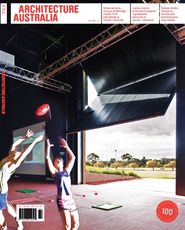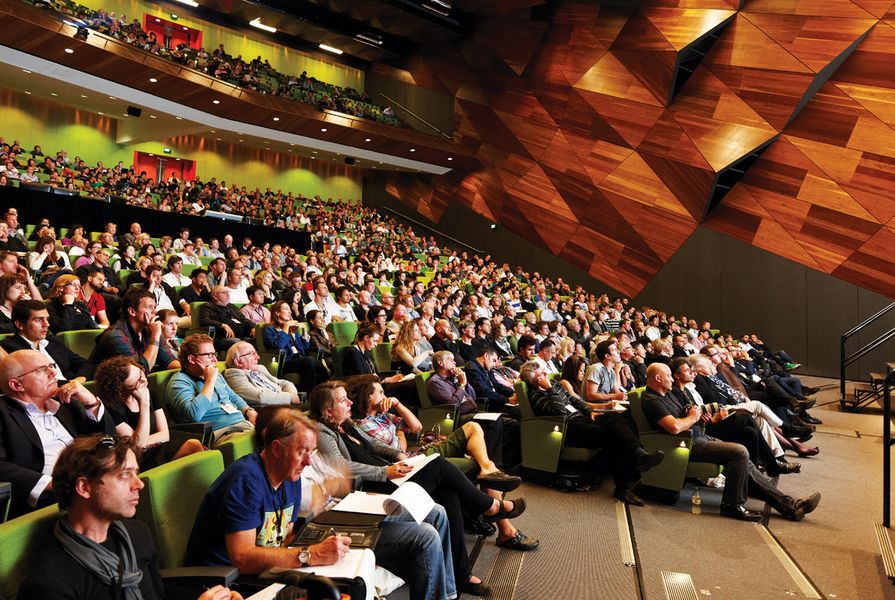At the 2011 national conference Natural Artifice, creative directors Angelo Candalepas, Andrew Scott and David Neustein presented an impressive feast of ideas and artefacts from around the world, complete with visual and musical palate cleansers. The menu was deliberately diverse, in an effort to invite many and varied interpretations around the theme of the human-environment condition. Evidently the directors intended for the discussion to move beyond a simplistic vision/division of the world, through an articulated belief in “wholeness” and “the essential character of things.” Candalepas argued publicly on several occasions that “we are all essentially the same,” but it became (sometimes painfully) clear that this is not the case.
It is difficult to conceive of two more diametrically opposed positions than the opening and closing acts: French visitors François Roche and Stephanie Lavaux of R&Sie, and acclaimed Finnish architect and theorist Juhani Pallasmaa. Roche and Lavaux are situated at what Hélène Frichot described as the “boundaries” of architecture, legitimizing fiction as a design practice. Presenting themselves as fictional characters and employing a variety of props – hair, glasses, hats – to further their physical ephemerality, Roche and Lavaux took us on a journey through their “biotopological battlefield,” illustrated through a series of parametric, robotic and pathologic provocations.
Conversely, Juhani Pallasmaa focuses on the material, embodied and lived dimensions of architecture. For Pallasmaa, architecture “withers” when it departs too far from the primacy of dwelling. Noting his concerns for the current fascination with the digital world within architecture, but resisting dismissing it outright, Pallasmaa cautioned against the displacement of the “act of making” architecture. There is an interesting subtext of exclusion here in equating “architecture” with architectonics, but this was bypassed in the ensuing debate, which tended to slip into the digital-physical divide.
The most interesting conversations, however, occurred between the opening and closing speakers. Neatly side-stepping the binary trap, Anthony Burke subtly shifted the conceptual frame from “total fabrication” to “material agency” in his introduction to the San Francisco team of Lisa Iwamoto and Craig Scott. Following a rather literal but curiously beautiful interpretation of the conference theme through the peculiarities of the suburban hedge, Iwamoto dazzled the audience with the seductive parametric forms of the “cloud project” and the poetry of their physical manifestation through digital fabrication. Less convincing for me were the speculations on urban futures presented by Scott, where the lure of technology obscured the social and cultural context. On reflection, perhaps Iwamoto’s articulation of Mies’s maxim that there are “good reasons and real reasons” needs to be heeded here in articulating a more expansive (and accurate) premise for such speculations.
Operating in a completely different intellectual and physical terrain, Teresa Moller constructs what she terms an “architecture of the landscape” in her native Chile, through an intuitive rather than theorized response to place. To me, she was one of the most inspirational speakers at the conference. The potency of her work emerges from its simplicity – from the perfect informality and apparent serendipity of the location of the statues at Plaza La Paz, to the carefully crafted orthogonal interventions in the wild coastal landscape at Punta Pite. If you want to feel inspired, just take a look.
The interface between architecture and landscape takes a different turn in the work of Paisajes Emergentes (“Emerging Landscapes”), presented by Sebastian Mejia and Luis Callejas (aka “The Colombians”). The achievements of this practice in the few short years since its formation are unbelievable. Refreshingly honest, pragmatic and highly ingenious (if not devious), these young architects are able to leverage incredible outcomes by reconceptualizing architecture from built artefact to public space. Their work is political, polemical and speculative but doesn’t take itself too seriously – the image of floating houses, cars and cows in the skies over Heathrow is forever etched in my brain.
Architecture is evidently in great health in Hispanic parts of the world, with the creative directors dishing up another delight in Luis Mansilla. Similarly candid in his presentation, Mansilla clearly revels in the dynamics and contingencies of practice, arguing “the only happiness in architecture is when you find something that you were not looking for.” Here the shift in emphasis is from artefact to system, where the architecture becomes a game in which the client participates. His elemental approach to architecture combines the benefits of robustness, flexibility and the space for surprise, where “not everything is possible, but the possibilities are infinite.”
Moller, the Colombians and Mansilla collectively demonstrated an ability to engage meaningfully with the audience without the excesses of theory that sometimes threatened to over-burden the dialogue at the conference, particularly during the “debates.” I deliberately place this word in inverted commas since there was a palpable lack of genuine dialogue. The effort to frame each session through national speakers introducing international guests was well intended but, unfortunately, for the most part, led to a hierarchical division between international and national speakers that was never eroded in the ensuing panel discussions. I have to include two notable exceptions here – the interesting discussion that emerged between John Wardle and Luis Mansilla due, in great part, to Timothy Hill’s excellent facilitation, and the conversation between Sean Godsell and Juhani Pallasmaa which benefited from their personal relationship and evident mutual respect.
Offering even less possibility for debate, the Q&A session at the end of day one invited contributions from the audience but – in one of the most undemocratic displays I have ever seen at a conference – all questions were initially publicly rejected as unworthy. Instead, what followed was an embarrassing exchange between Candalepas and Roche with a series of comments thinly veiled as questions seeking consensus rather than discourse. The wrap up on day two was similarly disappointing – even with Roche notably absent the dialogue failed to emerge and the architectural angst could be cut with a knife.
The failure of the dialogue is a great shame because, otherwise, the creative directors delivered an excellent conference, albeit (in my opinion) one overly burdened by its theoretical inquiry. The carefully constructed menu of ideas, perspectives, artefacts and landscapes was an enjoyable feast. I would happily indulge in some more.
Tweets from Natural Artifice
@liquidarch | Melonie Bayl-Smith – #nartifice some frank discussion about practice teaching and architects needing alibis – 16 Apr via Seesmic for Android
@mttctr | Trent Middleton – #nartifice A lot of talk has been about speculative futures and speculative architecture but where was the ‘client’ in that? – 16 Apr via Twitter for iPhone
@dayaal | Sammy J – #nartifice What a wonderful architect and humble and wise man Fumihiko Maki is. A privilege to hear him. – 15 Apr via Twitter for iPhone
@neilzimmerman | Neil Zimmerman – After #nartifice I am now thinking of becoming a landscape architect and moving to South America – 18 Apr via TweetDeck
@_jimmywilson | James Wilson – #nartifice more timothy hill pls. Great discssn w wardle + mansilla, personal fav. Cept for the WTF mo’ at “forum”. Bring the awkward! – 16 Apr via TweetDeck
@johndemanincor | John de Manincor – Roche hiding behind hat & glasses – says does want to be starchitect looks like rock star #nartifice – 15 Apr via Twitter for iPhone
@helenejuliaf | Hélène Frichot – #nartifice 3/11 internationals were women and 3/14 locals were women… – 16 Apr via Twitter for iPhone
@JustineClark | Justine Clark – My partner, looking at the #nartifice program “Gosh, the ‘young architects’ seem to be over-whelmingly boys…” Indeed. What’s going on? – 15 Apr via Twitterrific
@dneus | David Neustein – At the recent #nartifice AIA Conference, many were upset by the predominance of male speakers. I’ve decided to launch an advisory panel… – 3 May via Twitter for iPhone
@Alysia_Bennett | Alysia Bennett – #nartifice day 1 highlight: the acceptance of chance & respect of landscape in the instinctive process of Moller. – 16 Apr via Twitter for iPhone
@marcustrimble | Marcus Trimble – Thank you to Andrew Mackenzie for knocking the rubbish digital/analog dichotomy on the head and moving the discussion on. #nartifice – 16 Apr via Tweetbot for iPhone
@WJien | Wei Jien – #nartifice Iwamoto Scott – poetic spatial ideas that reflect the technology of our time, from paper to digital models. Fantastic! – 16 Apr via Twitter for iPhone
@marcustrimble | Marcus Trimble – “I knew we were going to get a lot of dirt from Lend Lease” Peter Walker on how to build a fake headland at barangaroo. #nartifice – 16 Apr via Tweetbot for iPhone
@helenejuliaf | Hélène Frichot – #nartifice this conference may be the last metaphysical gasp of the discipline: Anthony Burke paraphrased – 16 Apr via Twitter for iPhone
@benhewett | Ben Hewett – #nartifice An interesting congruence: Day 2 started with Burke and ends with Pallasmaa saying architecture is a messy discipline – 16 Apr via Twitter for iPhone
Read more articles about the 2011 national architecture conference here.
Source

Discussion
Published online: 11 Oct 2011
Words:
Ceridwen Owen
Images:
Peter Bennetts
Issue
Architecture Australia, July 2011
















